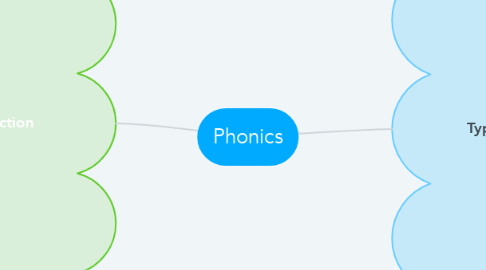
1. Effective Phonics Instruction
1.1. Develop Alphabetic Principle
1.1.1. Letters have sounds
1.1.2. Words have initial sounds
1.1.3. Some words have complicated elements like: consonant blends, consonant digraphs, vowel digraphs, diphthongs, or phonograms
1.1.4. Inventive reading and spelling
1.2. Develop Phonological Awareness:
1.2.1. Sounds of spoken words
1.2.2. Rhyming, word-to-word matching, sound-to-sound matching, initial and final sounds, segmentation, blending, deletion and manipulation
1.2.3. Encourage inventive spelling!
1.3. Learning Forms of Letters
1.3.1. Students should be able to immediately recognize a letter by their name and sound when they see it
1.4. Reading words in Isolation
1.4.1. This can help a student focus on the pattern of a word, or words without distraction of other words. This will help them automatically recognize words and certain word patterns
1.5. Reading words in stories
1.5.1. Students learn comprehension by reading words together, then building up to reading a while story. This helps them understand that words and stories have meaning
1.6. Writing words
1.6.1. Inventive spelling
1.6.1.1. Used by younger children, this helps them show what they know about letters, their sounds, and how they work together
1.6.2. Dictation
1.6.2.1. As children get older, their phonological awareness grows and they start using dictation and spelling words correctly
2. Types of Phonics Instructions
2.1. Analytic
2.1.1. Begins with word and breaks it down into parts
2.1.2. Example: Teacher writes the word 'Cat' on the board, and explains that the 'a' in cat makes the short /a/ sound. Then the teacher can ask the students to think of other words with the short /a/ sound. (rat, hat, mat...)
2.2. Synthetic
2.2.1. Starts with letters or groups of letters and teaches how to blend letters and sounds to form words
2.2.2. Example: The teacher can teach this method the opposite way as the example for analytic. The teacher would start with explaining that the letter A makes the short sound /a/. Then write a word on the board with the short sound /a/, such as cat, then have the students come up with other words with the short sound /a/.
2.3. Orton-Gillingham
2.3.1. Teaching letters and sounds through visual, auditory, kinesthetic and tactile approaches, then teaches how to form words by blending those letters and sounds.
2.3.2. Example: A teacher could show a letter to the class, and explain what letter it is and what sound it makes. Then the teacher would have the students trace the letter in the air, and on paper while saying the letter's name and the sound it makes. Once the students have learned all the letters, the teacher can show the students a word and they can all sound out and spell the word together.
